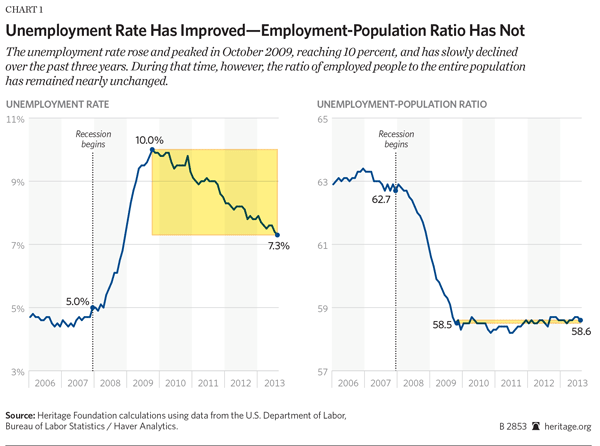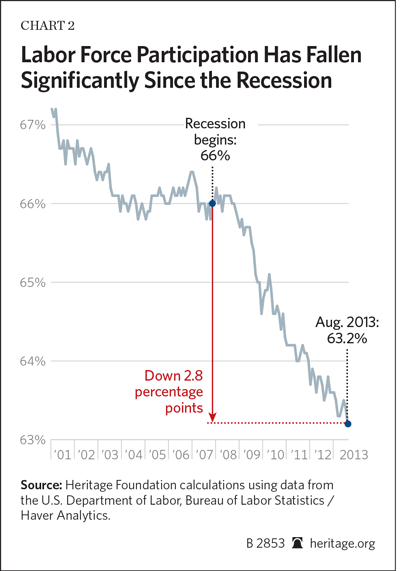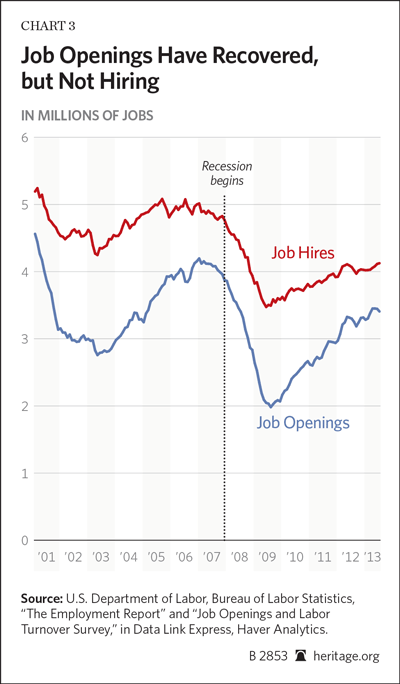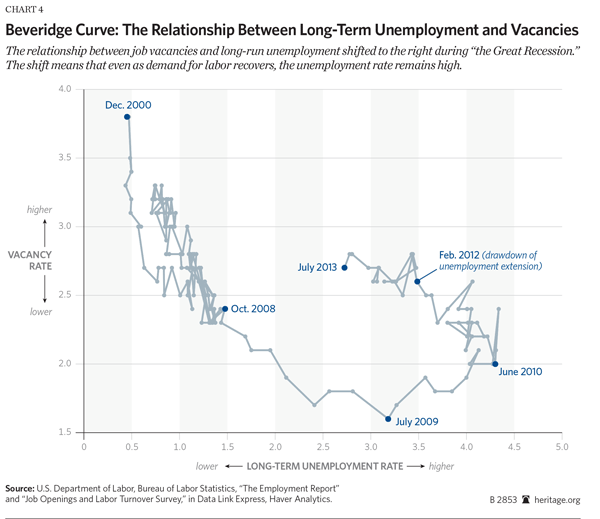According to the National Bureau of Economic Research, the “Great Recession” officially ended four years ago. Nonetheless, job growth remains anemic. Many economists have struggled to explain its prolonged weakness.[1] Neither weak demand nor mismatches between workers’ skills and job requirements can fully account for it. An overlooked cause may contribute to the problem: reduced labor supply.
Changes in government policy have reduced the reward for working, which will drive down the cost of labor. Approximately 4 million Americans laid off in the recession faced effective marginal tax rates near or above 100 percent, significantly reducing their attachment to the labor market. Obamacare has also raised effective marginal tax rates. By 2014, the median worker will face effective marginal tax rates exceeding 50 percent. Such high tax rates reduce labor supply and hold back the job market. Congress should pay closer attention to the disincentives to work that it has created.
Sluggish Labor Market
The labor market remains incredibly weak. The current economy has 1.9 million fewer jobs than when the recession began five and a half years ago.[2] Employment recovered within at least four years of the onset of every other postwar recession.[3] Although unemployment has fallen from its peak of 10 percent in October 2009, this drop has come entirely from people leaving the labor force instead of increased hiring. The employment-to-population ratio has barely changed during that time.[4]
The labor market recovery contrasts sharply with the rest of the economy. Although gross domestic product (GDP) has grown less than it usually does during recoveries,[5] it has nonetheless grown 4.6 percent beyond its pre-recession peak.[6] The stock market and corporate profits have similarly recovered. What has kept people from finding jobs?
Causes of Unemployment
Several factors can cause unemployment:[7]
- Demand-side (cyclical)[8] unemployment occurs when employers have no interest in hiring more workers. They foresee low demand for their products and wish to reduce their labor costs. Falling demand clearly drove the rapid decrease in employment in the manufacturing and construction sectors in 2007–2009. In times of economic uncertainty, consumers put off major purchases, such as a house or car. This reduces labor demand—and thus employment—in these sectors.
- Supply-side unemployment occurs when jobseekers become less willing to accept job offers and require higher pay to induce them to work.[9] This can happen for a number of reasons, such as increased labor taxes that reduce the reward for working. Alan Krueger, the former chair of President Obama’s Council of Economic Advisers, has written about how extended unemployment benefits reduce labor supply.[10] Extended benefits reduce the pressure to accept available job offers and prolong unemployed workers’ job searches.
- Mismatch unemployment increases when matching workers with available jobs becomes more difficult.[11] This can occur if jobs are lost primarily in one area of the country and gained in another, requiring the unemployed to move to find work (geographic mismatch). It can also occur if the skills the unemployed possess differ from those that employers need (skill mismatch).[12]
These distinctions matter, and the appropriate policy response differs according to the type of unemployment occurring.
Mismatch Only Part of the Problem
Mismatch unemployment seems an intuitively attractive explanation for the severity of the recession. Approximately half of the jobs lost between 2008 and 2009 were in construction and manufacturing. The collapse of the housing market also left millions of homeowners underwater, making it difficult for them to move to find work. Worker retraining programs or subsidies for moving would appear to represent a positive middle ground between compassion and callousness.
Despite this intuitive appeal, studies find that, while some mismatch exists, it is not the primary cause of the current labor market weakness. Edward Lazear and James Spletzer conclude, “There seems to be nothing [permanent] … about even the minor increases in occupational mismatch that occurred during the last recession.”[13] Peter Diamond also finds little role for skill mismatch in explaining the weak labor market.[14] Construction, the sector that was hardest hit by the recession, is bouncing back and does not look drastically worse than the rest of the labor market.[15] Geographic mismatch appears to be an even smaller factor.[16]
Economists at the Federal Reserve Bank of New York analyzed sectoral differences between unemployment and job vacancies in detail and concluded that skill mismatch explains at most one-third of the increase in unemployment during the recession, while geographic mismatch had a negligible effect.[17] Mismatch cannot explain most of the reduction in employment.
Reduced Demand Insufficient Explanation for Prolonged Slump
By process of elimination, many Keynesian economists conclude that insufficient demand must explain the labor market’s weakness.[18] Demand matters, but ignoring labor supply is a mistake. Falling demand clearly caused the sharp drop in manufacturing and construction employment between 2007 and 2009. Losses in these sectors alone accounted for about half of the net jobs lost in the economy during the recession.[19] Atif Mian and Amir Sufi show that large losses in household wealth particularly drove falling demand.[20] Nonetheless, weak demand by itself cannot explain the sluggish recovery in the labor market.
The factors holding down demand in 2008–2009 have substantially improved since then. Economic growth has resumed, and real GDP has risen 4.6 percent above pre-recession levels.[21] The Federal Reserve has pursed aggressive monetary stimulus, including asset purchases of $85 billion per month. In nominal terms, the economy has expanded 13.5 percent since late 2007.[22] Inflation-adjusted retail sales have risen 9 percent above pre-recession levels.[23] The stock market has also recovered its losses and hit new highs. Domestic corporate profits have recovered as well.[24]
All of these factors should increase the demand for goods and services—and thus labor—in the economy. If weak demand were the only factor holding back the labor market, employment should have rebounded with demand. It has not. Employment still remains below pre-recession levels.
Further, demand appears not to have dropped sharply in many sectors of the economy. When demand falls significantly, businesses typically reduce their use of both labor and non-labor inputs (e.g., energy, capital, materials, and buildings). Reductions happened in the manufacturing and residential construction sectors, where both labor hours and non-labor inputs fell by about the same amount. However, non-labor inputs grew slightly in the rest of the business sector even as employers cut jobs and hours.[25] This suggests that demand did not drop sharply across the entire economy. Otherwise, like manufacturing and construction firms, most businesses would use less energy, capital, and materials, as well as fewer employees.
This inability of mismatch and weak demand to account for the continued weakness of labor markets suggests labor supply problems are a contributing factor. Several pieces of evidence support this view.
Falling Labor Force Participation
The labor force has significantly contracted. Labor force participation has fallen steadily since the beginning of the financial crisis, with no indication of recovery in sight. From December 2007 to August 2013, labor force participation fell by 2.8 percentage points—almost 6 million more Americans who are neither working nor looking for work. Demographic factors, such as retirement of the baby boomers, account for only one-quarter of this drop.[26] More Americans are staying in school or collecting disability benefits—both the intended recipients and those who fraudulently report unverifiable medical conditions.[27]
Most economic analyses attribute the drop in labor force participation to reduced hiring and job opportunities.[28] The weak job market has certainly encouraged millions of Americans to pursue options outside the workforce. School, government benefits, and other alternatives to work become relatively more attractive as jobs become harder to find.
However, causality also runs in the other direction. Reduced labor supply reduces hiring. Companies cut hiring when prospective workers leave the labor force. If millions of workers had not stopped looking for work, employers would have created more jobs.[29] In the aggregate, many of the workers who dropped out of the labor force would have found jobs if they had kept looking.
Hiring vs. Vacancies
Another piece of evidence about the importance of labor supply is that the relationship between job vacancies and unemployment has changed. Broadly speaking, the number of job openings reflects labor demand in that it indicates employer interest in hiring workers. Actual hires reflect a combination of both supply and demand: firm interest and worker willingness to accept jobs at the offered wages. During the recession, the number of monthly job openings dropped by 1.8 million—almost 50 percent.[30] Since then, the number of monthly job openings has increased by 1.4 million, nearly back to pre-recession levels.[31] This indicates that labor demand dropped sharply during and after the financial crisis and subsequently (mostly) recovered.
Data on hiring paint a very different picture. The gross number of hires each month also fell sharply (–1.3 million) during the recession. Unlike job vacancies, however, monthly hiring has only partially recovered since then (+0.6 million).[32] This suggests that the labor supply has recovered less than demand has.
Outward Shifting Beveridge Curve
Economists model the relationship between job vacancies and unemployment with a Beveridge Curve, such as displayed in Chart 4. One axis displays the rate of job vacancies in the economy and the other the unemployment rate. Typically, unemployment falls as the number of job vacancies increases, and vice versa. During the recession the economy shifted down the curve, and job vacancies fell and unemployment increased. The relationship between job vacancies and unemployment did not change. During the recovery the Beveridge Curve itself shifted, so that the same number of job vacancies now correlates with much higher unemployment.
Rand Ghayad and William Dickens of Northeastern University show that the Beveridge Curve has not changed for the short-term unemployed, but has drastically worsened for the long-term unemployed.[33]
The shift in the Beveridge Curve for just the long-term unemployed is puzzling. Research finds long-term unemployment carries less stigma where unemployment is high.[34] When job vacancies fall, employers recognize that prolonged unemployment is less likely to reflect individual shortcomings. Thus, if anything, the job-finding rates of the long-term unemployed would be expected to improve relative to the short-term unemployed after 2009. This would have shifted the long-term Beveridge Curve to the left. Instead, Ghayad and Dickens find it shifted sharply to the right, which suggests that some—although not all—of the long-term unemployed have become less willing to accept job offers. Labor supply appears to have dropped since 2007.
Higher Effective Marginal Labor Taxes
What could have shifted the labor supply so significantly? Ghayad and Dickens hypothesize that government policy may be to blame. They write:
Another possibility is that the long-term unemployed in this recession may be searching less intensively—either because jobs are much harder to find or because of the availability of unprecedented amounts and durations of unemployment benefits.… [I]f a drop in search intensity is due only to the difficulty of finding jobs, it again raises the question why we would not see that phenomenon at shorter durations as well.[35]
Part of the effect of extended unemployment insurance (UI) benefits may come from prompting more people to continue reporting an “unemployed” status when they would otherwise have dropped out of the labor force.[36] This could explain the outward shift in the Beveridge Curve shown in Chart 4, but it cannot explain why so few people have moved back into employment. Nor can it explain why the rightward shift also shows up in the U6 Beveridge Curve, which includes people who give up looking for work.
Considerable evidence supports the hypothesis that expanded spending on welfare programs has reduced labor supply. Congress significantly expanded means-tested benefits during the recession. UI increased from 26 weeks to 99 weeks and remains at 63 weeks in most states.[37] Food stamps, mortgage interest forgiveness, health care premium subsidies, and other programs also became more widely available.[38]
Income-replacement programs can provide important support to people in difficult situations. However, they also reduce the reward for working. Because they phase out—or are eliminated entirely in the case of UI—as income rises, they have the same labor market effects as raising taxes: part of each extra dollar earned is clawed back by reduced program benefits. This makes working relatively less attractive. Casey Mulligan of the University of Chicago finds that the effective marginal tax rate for the median worker rose 5 percentage points between 2007 and 2013.[39] He further finds that “among the 23 million layoffs experienced by non-elderly American household heads and spouses during the recession, at least 4 million of them resulted in penalty rates near or above 100 percent.”[40]
Raising effective marginal tax rates to such levels reduces the potential employees’ willingness to work.[41] Few Americans would work 40 hours a week if it did not help them provide for themselves and their families. Mulligan finds a strong correlation between increased effective marginal tax rates and reductions in work hours during and after the recession. Groups that had larger increases in their effective marginal tax rates saw employment drop by far more than similar groups with smaller effective tax increases.[42] Mulligan estimates that the expanding social safety net “explains a large fraction of the reduction in labor hours … since 2007.”[43]
The implementation of Obamacare will exacerbate this problem. The law’s subsidies for purchasing health coverage from the “exchanges” phase out as income rises. Neither the individual nor employer mandate/tax apply to unemployed workers. They pay these taxes only if they start working.[44] As a result, the health care law will raise marginal labor tax rates by about 10 percentage points on half of the U.S. workforce.[45] This equates to doubling the Social Security payroll tax on affected workers. Consequently, the median worker will face an effective marginal tax rate of more than 50 percent by 2015.[46] This will further reduce labor supply and suppress job creation. The Congressional Budget Office projects that Obamacare will induce 800,000 workers to leave the labor force.[47]
What About Wages?
Several economists have objected to the notion that labor supply has fallen because, if true, this should create “upward pressure on wages.”[48] This does not appear in the data: Nominal wage growth has slowed since the recession began. Average nominal private-sector wages have risen only 2 percent per year since 2009.[49] This seems to rebut the notion that the labor supply has fallen.
However, economists would not necessarily expect compensation to rise if demand fell along with supply. The ultimate effect on wages depends on the magnitude of the shifts in supply and demand and their relative elasticities.
It is well established that wages respond more strongly to shifts in labor demand than to shifts in labor supply.[50] Consequently, a decrease in labor supply has a relatively greater effect on employment than on pay, while a decrease in demand has a relatively greater effect on pay than on employment.[51]
Equal reductions in supply and demand should cause wages to fall because the reduction in labor supply would produce less upward pressure on wages than the downward pressure created by the drop in demand. The fact that nominal wages have grown, albeit sluggishly, despite the drop in demand in the recession suggests that labor supply fell significantly more than demand fell.[52]
Solutions
These problems have no simple solutions, but a first principle would be to do nothing that exacerbates them. With that in mind, Obamacare should be repealed before its deleterious effects are felt more broadly in the labor market.
Some of the policies that have weakened labor supply over the past several years can be undone. Congress should strengthen the asset test for food stamps, which was relaxed in 2002 and further relaxed in 2008.[53] The taxpayers should not be providing basic necessities to those with significant private wealth, even if they presently have no income.
In providing a minimum standard of living to those truly in need, Washington needs to re-emphasize the work requirement to counteract the disincentives to work welfare programs can create. The Obama Administration has liberally granted waivers to the work requirement for food stamps. It has also gutted welfare reform by granting waivers to the work requirement for Temporary Assistance for Needy Families (TANF) beneficiaries.[54] Congress should repeal these waivers. Taxpayers expect those receiving assistance to do their best to find work and retake financial responsibility for themselves. It is reasonable for the government to push able-bodied adults to work hard in looking for work, even in a subpar labor market.
Conclusion
Many commentators routinely insist that insufficient demand entirely drives America’s continued labor market weakness and dismiss labor supply concerns.[55] However, economists generally believe that people make decisions in their own interests, will not work for nothing, and will respond to incentives. Analysis ignoring half of the market inevitably leads to bad policy.
Neither mismatch nor insufficient demand can explain why employment rates have not improved in four years. Considerable evidence suggests that the labor supply has also fallen, holding back job creation. Labor force participation has fallen sharply over the past four years. Even as the number of job openings has rebounded, hiring rates have not. Changes in government policy have raised effective labor tax rates. Implementation of the health care law will raise the average effective marginal tax rate on the median worker above 50 percent next year. Such rates strongly discourage labor force participation. Congress should reform social assistance programs to reduce the disincentive to work.
—James Sherk is Senior Policy Analyst in Labor Economics and Salim Furth, PhD, is Senior Policy Analyst in Macroeconomics in the Center for Data Analysis at The Heritage Foundation.






